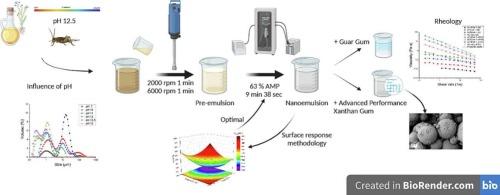超声驱动蟋蟀蛋白纳米乳的优化:pH和流变稳定剂的影响
IF 9.7
1区 化学
Q1 ACOUSTICS
引用次数: 0
摘要
本研究以蟋蟀蛋白为天然乳化剂,亚麻籽油为分散相,研究了可持续纳米乳液的配方,重点研究了pH、超声和流变改性剂对乳液稳定性和结构的影响。表面和界面张力分析显示,随着蛋白质浓度的增加,表面和界面张力显著降低,稳定在≥1 g/L。在碱性pH值(≥12)下,由于蛋白质溶解度和表面活性的增强,界面张力变得无法测量,因为完全的相合并。液滴粒径在不同pH值下均呈现双峰分布,在pH值12.5时直径最小(0.54 μm),直径最大(1.91 μm)。利用响应面法优化超声参数(振幅和超声时间)。在振幅为63%、超声时间为9.6 min时,得到了最小的液滴尺寸(0.365 μm)。然而,更高的能量输入也增加了多分散性,这可能是由于在缺乏足够乳化剂的情况下液滴的恢复。为了提高稳定性,对瓜尔胶(GG)和高性能黄原胶(APXG)进行了测试。APXG,特别是≥0.25 wt%时,显著改善了粘弹性(G ' > G″),增加了稠度(0.5 wt%时K = 9.87 Pa·sn),形成凝胶状结构,并在21天内降低了Turbiscan稳定性指数(TSI)。这些结果强调了pH值、超声波处理和流变改性在设计坚固的纳米乳液中的关键作用。在优化条件下,蟋蟀蛋白与APXG的结合为制备稳定、环保的功能性食品和营养保健品乳剂提供了良好的平台。本文章由计算机程序翻译,如有差异,请以英文原文为准。

Ultrasonication-driven optimization of cricket protein nanoemulsions: influence of pH and rheological stabilizers
This study investigates the formulation of sustainable nanoemulsions using cricket protein as a natural emulsifier and linseed oil as the dispersed phase, emphasizing the effects of pH, ultrasonication, and rheological modifiers on emulsion stability and structure. Surface and interfacial tension analyses revealed significant reductions with increasing protein concentration, stabilizing at ≥1 g/L. At alkaline pH (≥12), interfacial tension became unmeasurable due to complete phase merging, attributed to enhanced protein solubility and surface activity. Droplet size distribution exhibited bimodal patterns across all pH levels, with the smallest Sauter diameter (0.54 μm) and optimal span (1.91) achieved at pH 12.5.
Ultrasonication parameters (amplitude and sonication time) were optimized using response surface methodology. The smallest droplet size (0.365 μm) was predicted at 63 % amplitude and 9.6 min of sonication. However, higher energy inputs also increased polydispersity, likely due to droplet recoalescence in the absence of sufficient emulsifier. To enhance stability, guar gum (GG) and advanced performance xanthan gum (APXG) were tested. APXG, particularly at ≥0.25 wt%, significantly improved viscoelasticity (G′ > G″) and increased consistency (K = 9.87 Pa·sn at 0.5 wt%), forming gel-like structures and reducing the Turbiscan Stability Index (TSI) over a 21-day period.
These results underscore the critical roles of pH, ultrasonic processing, and rheological modification in designing robust nanoemulsions. The integration of cricket protein and APXG under optimized conditions offers a promising platform for stable, eco-friendly emulsions in functional food and nutraceutical applications.
求助全文
通过发布文献求助,成功后即可免费获取论文全文。
去求助
来源期刊

Ultrasonics Sonochemistry
化学-化学综合
CiteScore
15.80
自引率
11.90%
发文量
361
审稿时长
59 days
期刊介绍:
Ultrasonics Sonochemistry stands as a premier international journal dedicated to the publication of high-quality research articles primarily focusing on chemical reactions and reactors induced by ultrasonic waves, known as sonochemistry. Beyond chemical reactions, the journal also welcomes contributions related to cavitation-induced events and processing, including sonoluminescence, and the transformation of materials on chemical, physical, and biological levels.
Since its inception in 1994, Ultrasonics Sonochemistry has consistently maintained a top ranking in the "Acoustics" category, reflecting its esteemed reputation in the field. The journal publishes exceptional papers covering various areas of ultrasonics and sonochemistry. Its contributions are highly regarded by both academia and industry stakeholders, demonstrating its relevance and impact in advancing research and innovation.
 求助内容:
求助内容: 应助结果提醒方式:
应助结果提醒方式:


